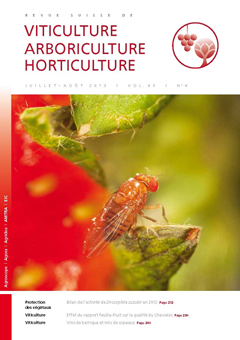
Issue 4 - July - August 2013
Abstract in open access
In less than two year the Spotted wing drosophila (Drosophila suzukii) definitely established in Switzerland. All over the country, more than 60 000 individuals were captured in the national survey launched by Agroscope in collaboration with the cantonal phytosanitary services in 2012. The insect was captured from the foothills to the subalpine zone and the most important populations were observed in the Ticino. Drosophila suzukii’s peak of activity was determined from the mid of September to the end of October. Most individuals were caught in berry plantations, in particular in Autumn raspberry, as well as at the boarder of vineyards. However, traps placed in hedgerows captured also a great number of D. suzukii, especially when they also consisted of elderberry or viburnum. In conclusion, the use of monitoring traps allows to detect the presence of the pest in a region, a crop or a plantation in a reliable way.
Keywords: Drosophila suzukii, invasion, pest insect, trapping, vinegar trap, Switzerland
E-Mail: catherine.baroffio@agroscope.admin.ch
Adress: Agroscope, 1964 Conthey
Abstract in open access
The Scaphoideus titanus Ball. is a Nearctic leafhopper known as a polyphagous species. Since its outbreak in the Palearctics in the 1950ies, this sole vector of the Flavescence dorée disease was considered as a monophagous species restricted to the genus Vitis. An adequate understanding of the spatio-temporal distribution of S. titanus is important for rationalizing pest management procedures and improving a phenology model in an adaptive management framework. This study carried out in 2009–2010 to evaluate the role of spontaneous interrow vegetation on the dynamics of S. titanus populations showed that: i) both grapevine canopy and inter-row vegetation are inhabited by S. titanus; ii) relative densities in grapevine canopy and in inter-row vegetation vary during the season; iii) the survivorship of nymphs on common species of the inter-row vegetation is higher on Trifolium repens than on Ranunculus repens.
Keywords: feeding preference, nutritional host plants, wild plants, sampling
E-Mail: mauro.jermini@agroscope.admin.ch
Adress: Agroscope, 6593 Cadenazzo
Abstract in open access
In 2006, on the experimental estate of Agroscope ACW at Leytron (Wallis), various plant densities were tested on Chasselas grapevines. Inter-row distances together with leaf hedge height were varied in order to obtain a sufficient leaf-fruit ratio (exposed leaf surface SFE per kg of grapes rising to 1.1 m2). For a same yield per surface unit and an equivalent SFE/kg ratio, plant density exerted no noticeable effect on the sugar content of grapes or on must acidity. The fertility of buds, the berry weight and the cane-stem pruning weight were not influenced by plant density. Only the formol index (content of assimilable nitrogen in musts) increased in hedgerows with narrow spacing and smaller leafed hedges. The inter-row distance had no influence on water supply to the vine, nor did it affect the content of mineral elements in the foliage. As far as organoleptic quality was concerned, plant density had no effect on the quality of wines, given that the SFE/kg ratio of grapes was sufficient and equivalent for all the tested variants.
Keywords: plant density, leaf-fruit ratio, water supply, quality of grapes and wine
E-Mail: vivian.zufferey@agroscope.admin.ch
Adress: Agroscope, 1009 Pully
Abstract in open access
In spite of the legally permitted use of oakwood chips and pieces in winemaking, this recent enological technique is still a matter of debate. Various legal, economic and ethical reasons call for establishing an analytical method to identify whether a wine has been aged in barrel or treated with oak chips, which cannot be achieved by sensorial means. This was the Barcop project’s main goal (run 01.2009–05.2011). Using marketable wines of various varieties and origins, the determination (by GC-MS) of empyreumatic xylovolatile compounds of 1017 certified wines aged in new and used barrels and of 600 certified oaked wines allowed to build an extended database. Challenging the database with an unknown wine via logistic regression led to a correct identification of the wood treatment (barrel 94 % or oakchips 93 %).
Keywords: barreled wines, oaked wines, database, differentiation, logistic regression
E-Mail: andre.rawyler@eichangins.ch
Adress: Médiplant, 1964 Conthey
Abstract in open access
Types of red wines from the Cabernet franc were identified through the expertise of professionals: first by interviewing and then out of sensory data on experimental wines from a jury of untrained professionals and from a trained panel. The characterization by professionals allowed the identification of the types of wine, while the trained panel, considered as a reference, allowed the validation of the typology. The results show that a consensus was easily reached between professionals to identify the types of wines, but not for sensory evaluation. They correctly characterized both most extreme types: “Vegetal-Light” and “Fruity- Full-bodied-dry tannins”. This identification method will be used to design decision aid tools to optimize practices depending on the well-adapted type of wine.
Keywords: expertise, PLS, support decision aid tool, wine
E-Mail: c.coulon@groupe-esa.com
Adress: Ecole supérieure d'agriculture d'Angers ESA, F-49007 Angers Cedex 01

 Download of full issue
Download of full issue
 Download article
Download article